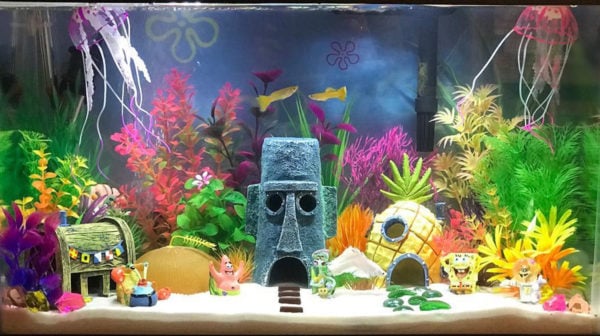Aquatic plant nurseries reproduce many plant species in emergent conditions for a variety of reasons such as, unlimited access to carbon dioxide (CO2) and the benefits of natural sunlight. Emergent growth can produce variations in leaf coloration and shape, making some plants look dramatically different. One example is the unusual leaf adaption of Hygrophila difformis (Water wisteria) when exposed to the atmosphere (see photo). Emersed growth is possible because in nature, many of these species are actually amphibious, living along the edges of streams, lakes or in low flood plains. During rainy seasons, they quite happily spend a considerable amount of time completely submerged.
Getting plants to grow emersed (indoors) is very easy using one of two options:
- Covered (highly humid) partially-filled tank. Filling the aquarium one-half to three-quarters full is ideal. This gives plenty of room for the plants to grow above the water’s surface. Being that the tank is covered, lighting can rest above the glass cover in the normal fashion. This option provides the maximum amount of humidity but the glass cover limits plant height.
- Open-topped aquarium. Lighting usually requires the use of a glass cover so in this case, it needs to be suspended above the tank. A major advantage of this option is the ability of plants to grow quite high.
I have had the most success with emergent-growing plants by keeping the humidity above 80 percent. Option one is normally the best course of action since most homes are maintained at about 35 to 45 percent humidity.
Let’s first examine Java Fern (Microsorium pteropus) which can grow submerged, emersed or completely out of water. A lot of moisture is the key to success for growing these plants emersed or completely out of the water. Option one is recommended to get them to completely grow out of the water.
Anubias is another excellent choice for option one. Like Java Fern, they will grow submerged, emergent or completely out of the water. Growing out of the water, Anubias, unlike Java Fern, will send some roots down into the substrate. The number of roots can vary from a single root to a jungle-like mass. Not all of the roots will reach the substrate nor will they all attach to an object. The roots are similar to air roots seen on large trees in the rainforest which are there to collect nutrients. To start emergent or out of the water growth of Anubias and Java Fern, gently attach these plants to a log or rock using cotton thread. Over time, the plants will attach their roots and the thread will slowly dissolve. If your tank is not tightly covered, the use of waterfalls or spray bar fish tank filters greatly help increase the humidity of the air. The log or rock that they are attached to only needs to be consistently wet. Both of these plants are very low light tolerant.
Hygrophila difformis (Water wisteria) and Ceratopteris thalictroides (Water sprite) are excellent plants for emergent growth. Nothing needs to be done to get these plants to grow above the water’s surface other than providing sufficient overhead lighting. In an open top aquarium, I have seen them grow as much as six-inches out of the water. The emergent leaves lack pinnation and are very interesting. To expedite the emergent growth, simply take a cutting and let it float on the water’s surface.
Good choices for emergent growth include:
- Echinodorus: varieties – Kleiner Bar, Ozelot, Rubin and uruguayensis
- Crytocoryne: varities – cordata, wendtii, undulata and wendtii (Red)
- Aponogeton: varieties – crispis, boivinianu
- Ceratophyllym
- lindernia grandiflora
- Bacopa caroliniana
Oftentimes, Echinodorus are shipped to pet shops towering more than a foot and a half tall. In this case, simply root this plant in a nutrient rich substrate and you have an instantly grown emergent plant. Your aquarium conditions will certainly be different than what the plant was accustomed to so be patient while the plant adapts to its new environment. Make sure there is plenty of humidity and to help, mist the leaves frequently.
The fact is, most of the plants we purchase for our aquariums are emergently propagated. The challenge is when we bring them home and submerge them in our tanks! Suddenly, this lush plant now finds itself in dim lighting and restricted from an endless supply of CO2 and other nutrients. Every plant needs an adjustment period. Give emergent growth a try. It is fun and creates endless opportunities for aquascapes to transcend the aquarium into your home.
Story and photo by: Stephen G. Noble
Share:









